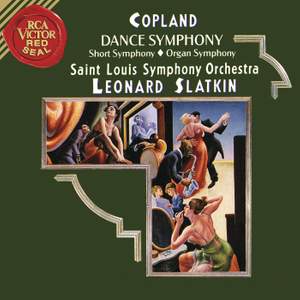
Aaron Copland (1900-1990)
Symphony for Organ and Orchestra (1924)
Dance Symphony (1929)
Short Symphony (Symphony No 2) (1932-3)
Orchestral Variations (1930, orch. 1957)
Saint Louis Symphony Orchestra/Leonard Slatkin
rec. 1993/95, Powell Symphony Hall St. Louis, USA
Presto CD
RCA 09026682922 [67]
Towards the end of the last century Leonard Slatkin made a series of recordings of American music for RCA which seem to me to have been among the best things he has done. (I am aware that he has rerecorded some of these works more recently.) Composers represented were Charles Ives, Samuel Barber, William Schuman, Walter Piston, Aaron Copland, John Corigliano and maybe others. He recorded three discs of Copland’s music, of which this is the first, available again on CD thanks to Presto’s admirable reissue programme. I hope that the others will follow in due course. Incidentally, they had delightful cover pictures.
Any discussion of Copland’s symphonies has to begin with sorting out their numbering which is not straightforward. There are actually five works he called symphonies. Here they are, with dates of composition, not premiere:
– Organ Symphony (Symphony for organ and orchestra) (1924)
– Dance Symphony (1925) (Unnumbered, based on music for the ballet Grohg)
– Symphony No 1 for orchestra (1928) (a reworking of the Organ Symphony with the organ part removed)
– Short Symphony (Symphony No 2) (1931–33)
– Symphony No 3 (1944–1946)
What we have here are the three earlier ones, but with only the original version of the Organ Symphony. He revised this, removing the organ part and distributing it among other instruments to make the work easier to perform and also more accessible. He then numbered it Symphony No 1. As is the way with such things, everyone prefers the original, and the supposedly more popular revision is rightly considered a much weaker version.
All these works belong to Copland’s modernist side, fresh from his studies with Nadia Boulanger in Paris, for whom the Organ Symphony was written, and very different from the popular idiom he adopted for his cowboy ballets. I like those, but I like this side of his work too. The organ part in the symphony is not a concertante one but part of the texture. There are three movements: the first a quiet prelude, the second a Scherzo showing the influence of Stravinsky, but also displaying what Copland saw as ‘what could be done to adapt the raw material of jazz.’ The finale has a somewhat angular lyricism of a Hindemithian kind before moving on to more vigorous rhythms.
The Dance Symphony was written in haste and takes its material from a then unpublished ballet called Grohg. He was a vampire magician who specialised in the raising of corpses and the work has a suitably sinister atmosphere throughout. A slow start with muted brass leads to an energetic Allegro, which in the ballet was titled ‘Dance of the Adolescent.’ The second movement was originally titled ‘The Girl who moves as if in a Dream’ and is expressionist. The finale is fierce.
The Short Symphony is indeed short, but it is also rhythmically so tricky that two planned premieres had to be cancelled because orchestras could not cope with it. Because of this, Copland rescored the work as a sextet for chamber forces. This is quite different in mood from the Dance Symphony, with the first movement lively with irregular rhythms, the slow second movement expressive in an acrid way and the finale playful.
The Orchestral Variations, although dated 1957, are actually based on a 1930 piano work, orchestrated many years later. This is the most severe music on the disc, dissonant, aggressive and often rhythmically insistent. It is, nevertheless, a good piece.
Slatkin secures good and confident performances of these often very tricky works. I take it that the orchestra had had opportunities to play them in concert before taking them into the studio; they certainly sound secure. For American orchestras these works are presumably core repertoire, and this shows. More recently John Wilson has recorded most of these works and, good though the BBC Philharmonic is, they don’t show the same familiarity with the idiom as do Slatkin and his Saint Louis Symphony Orchestra. The recording is good and those wishing to explore Copland beyond the cowboy ballets should consider this. Slatkin has also recorded the third symphony (in the composer’s numbering), and we must hope that this also returns to the catalogue.
Stephen Barber
Help us financially by purchasing from



















